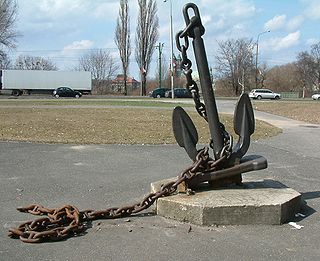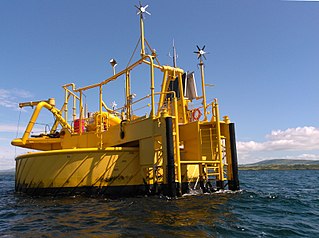
An anchor is a device, normally made of metal, used to secure a vessel to the bed of a body of water to prevent the craft from drifting due to wind or current. The word derives from Latin ancora, which itself comes from the Greek ἄγκυρα.
Moor or Moors may refer to:

Seamanship is the art, knowledge and competence of operating a ship, boat or other craft on water. The Oxford Dictionary states that seamanship is "The skill, techniques, or practice of handling a ship or boat at sea."

A lightvessel, or lightship, is a ship that acts as a lighthouse. They are used in waters that are too deep or otherwise unsuitable for lighthouse construction. Although some records exist of fire beacons being placed on ships in Roman times, the first modern lightvessel was off the Nore sandbank at the mouth of the River Thames in England, placed there by its inventor Robert Hamblin in 1734. The type has become largely obsolete; lighthouses replaced some stations as the construction techniques for lighthouses advanced, while large, automated buoys replaced others.

A mooring is any permanent structure to which a seaborne vessel may be secured. Examples include quays, wharfs, jetties, piers, anchor buoys, and mooring buoys. A ship is secured to a mooring to forestall free movement of the ship on the water. An anchor mooring fixes a vessel's position relative to a point on the bottom of a waterway without connecting the vessel to shore. As a verb, mooring refers to the act of attaching a vessel to a mooring.
A bit is a symbol used for communication or, equivalently, a unit of information storage on a computer. A bit is also used as a unit of information.
An anchor is a device that attaches to the sea bottom to prevent a boat from drifting.

A sea anchor is a device that is streamed from a boat in heavy weather. Its purpose is to stabilize the vessel and to limit progress through the water. Rather than tethering the boat to the seabed with a conventional anchor, a sea anchor provides hydrodynamic drag, thereby acting as a brake. Normally attached to a vessel's bows, a sea anchor can prevent the vessel from turning broadside to the waves and being overwhelmed by them.

A swivel is a connection that allows the connected object, such as a gun, chair, swivel caster, or an anchor rode to rotate horizontally or vertically.

The killick hitch is a type of hitch knot used to attach a rope to oddly shaped objects. This knot is also known as the kelleg hitch. It is a combination of a timber hitch tied in conjunction with a half hitch, which is added to lend support and stability when pulling or hoisting the object; the addition of a half-hitch in front of the timber hitch creates a timber hitch and a half hitch, known as a killick hitch when at sea. A killick is "a small anchor or weight for mooring a boat, sometimes consisting of a stone secured by pieces of wood".
Deadman or Deadman's may refer to:
The Finger Lakes Underwater Preserve Association (FLUPA) is a group of regional divers, associates, and families interested in promotion of scuba diving and the history and ecology of the Finger Lakes region of New York.
A mooring in oceanography is a collection of devices connected to a wire and anchored on the sea floor. It is the Eulerian way of measuring ocean currents, since a mooring is stationary at a fixed location. In contrast to that, the Lagrangian way measures the motion of an oceanographic drifter, the Lagrangian drifter.

A Single buoy mooring (SrM) is a loading buoy anchored offshore, that serves as a mooring point and interconnect for tankers loading or offloading gas or liquid products. SPMs are the link between geostatic subsea manifold connections and weathervaning tankers. They are capable of handling any tonnage ship, even very large crude carriers (VLCC) where no alternative facility is available.
Kite mooring refers to a specific method used to secure a kite in flight. The two fundamental parts of a kite are the wing and the kite line. The kite needs mooring to either a mobile or fixed object to develop the tension in the kite line. This converts to lift and drag enabling the kite to fly in its media.
A berth is a designated location in a port or harbour used for mooring vessels when they are not at sea. Berths provide a vertical front which allows safe and secure mooring that can then facilitate the unloading or loading of cargo or people from vessels.
Holdfast most often refers to:

An anchorage is a location at sea where ships can lower anchors.

Bitts are paired vertical wooden or metal posts mounted either aboard a ship or on a wharf, pier or quay. The posts are used to secure mooring lines, ropes, hawsers, or cables. Bitts aboard wooden sailing ships were large vertical timbers mortised into the keel and used as the anchor cable attachment point. Bitts are carefully manufactured and maintained to avoid any sharp edges that might chafe and weaken the mooring lines.
In underwater diving, a downline is a piece of substantial cordage running from a point at the surface to the underwater workplace, and kept under some tension. It can be used as a guideline for divers descending or ascending, for depth control in blue-water diving, and as a guide for transfer of tools and equipment between surface and diver by sliding them along the downline at the end of a messenger line. A shotline is a special case of downline which uses a heavy weight at the bottom and a float at the top. A jackstay is a more lateral equivalent, that commonly follows a surface, and will not usually allow materials transfer without a messenger line from the destination end.









